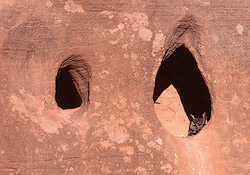 There is something mystical, borderline magical, to hear an owl call in the dead of night. These creatures explore, mostly, the nighttime world that shrouds the Canyon Country in darkness when many of us our tucked into our homes, hotels, or campsites.
There is something mystical, borderline magical, to hear an owl call in the dead of night. These creatures explore, mostly, the nighttime world that shrouds the Canyon Country in darkness when many of us our tucked into our homes, hotels, or campsites.
So, who are these denizens of the dark? Here are several of the Canyonlands region owls.
The most common species is the great horned owl, named for the two large ear tufts, called plumicorns (Latin for feathered horns) atop their head. The largest owl in Canyon Country, great horns nest in rock cavities, tree crotches, or usurp old redtail hawk or raven nests for their own. Their deep, booming calls often with the cadence that resembles Who’s Awake, Me Too can be heard from half a mile away.
Nicknamed “winged tigers” because of their hunting prowess, great horned owls consume a variety of prey including rabbits, small rodents, birds, and barnyard cats, thus enabling them to live in a wide variety of habitats. Their regurgitated owl pellets contain the undigestible bones and fur which enables the curious to examine the prey base of these owls.
Long-eared owls also have long ear tufts that the birds use not for hearing but for blending in with their surroundings. When alarmed, the owls may stand up straight and erect their ear tufts to mimic a tree limb to avoid detection.
These owls are mostly found nesting at higher elevations in wooded areas where they hunt small rodents, but will also take bats or snakes. The owl’s orangish facial disk and yellow eyes helps to identify them, as does their spaced, single-note calls that sound like a drawn out Whhoot.

Western screech-owls are small owls with yellow eyes and are cavity nesters, meaning they use large holes in trees for their nest sites. Active at night, these owls feed on small rodents, birds, and large moths, beetles, and even scorpions.
Screech owl calls have a soft series of whistled notes followed by a rapid trill. A lucky night is hearing a pair of these owls dueting with one another during the breeding season.
Another woodland owl that migrates from the region in winter is the flammulated owl. These small owls have some reddish feathers which gives them the nickname, “Flame owl.” Often found in aspen or ponderosa pine woodlands, these tiny owls are also cavity nesters, often utilizing abandoned woodpecker holes. These owls feed on large insects, moths, beetles, crickets, and occasionally small rodents or bats.
 The dark-eyed flammies are rarely seen, unless at a nest cavity. These birds are best identified by the soft, low hoots. Though they also make a variety peeps and twitters, the owls seem to throw their voices like a ventriloquist, making locating the birds very difficult.
The dark-eyed flammies are rarely seen, unless at a nest cavity. These birds are best identified by the soft, low hoots. Though they also make a variety peeps and twitters, the owls seem to throw their voices like a ventriloquist, making locating the birds very difficult.
Lastly, and in contrast to the mainly nocturnal owls, the burrowing owl is a species of open country, utilizing prairie dog or badger holes for its nest site. These birds are diurnal, meaning they are often active in the day chasing down grasshoppers, lizards, and small rodents. Their calls, which may be heard in the night as well, resemble harsh dove calls.
So, if you’re looking to explore the nocturnal world, take a walk along Moab’s Mill Creek Parkway or drive up to the Windows section in Arches National Park and give a listen to the night landscape and maybe you’ll hear one of these mystical creatures of Canyon Country, just don’t forget a flashlight!